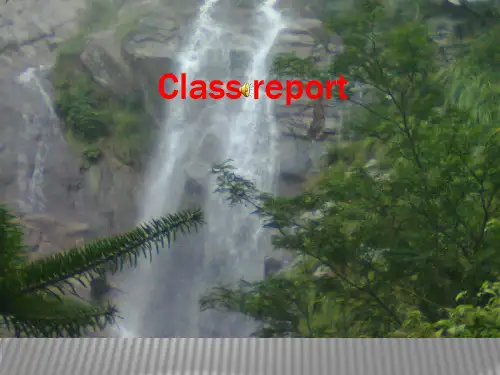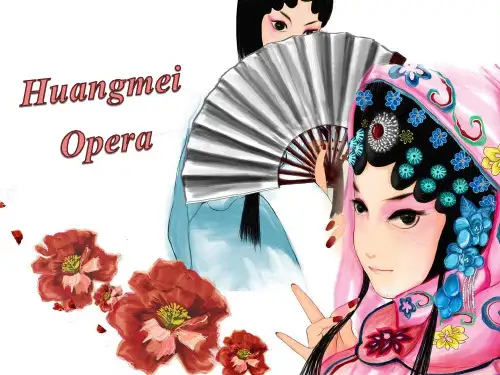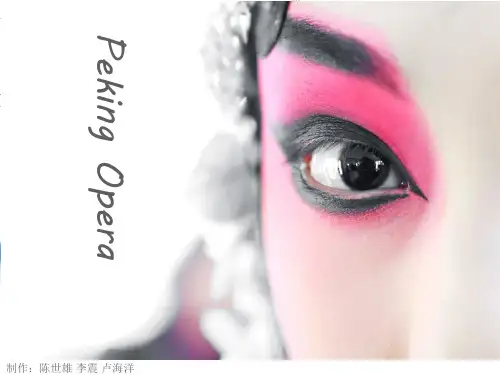黄梅戏英语-PPT(精)
- 格式:ppt
- 大小:884.00 KB
- 文档页数:8



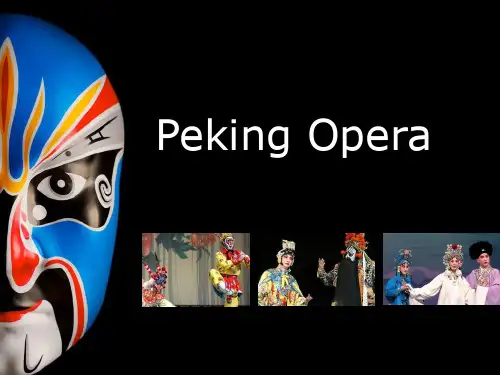
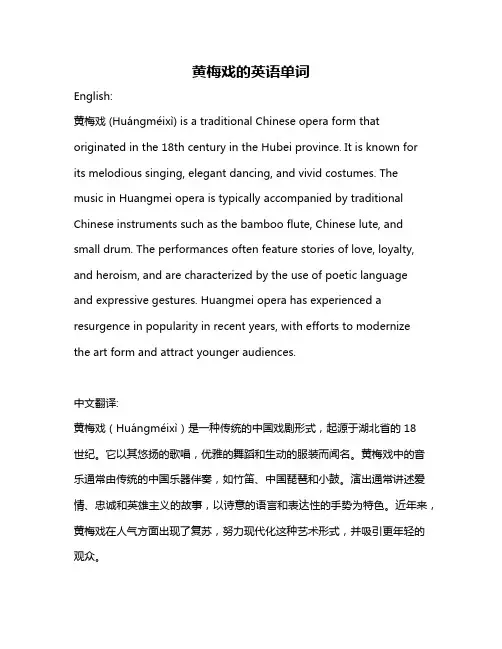
黄梅戏的英语单词English:黄梅戏(Huángméixì) is a traditional Chinese opera form that originated in the 18th century in the Hubei province. It is known forits melodious singing, elegant dancing, and vivid costumes. The music in Huangmei opera is typically accompanied by traditional Chinese instruments such as the bamboo flute, Chinese lute, and small drum. The performances often feature stories of love, loyalty, and heroism, and are characterized by the use of poetic languageand expressive gestures. Huangmei opera has experienced a resurgence in popularity in recent years, with efforts to modernizethe art form and attract younger audiences.中文翻译:黄梅戏(Huángméixì)是一种传统的中国戏剧形式,起源于湖北省的18世纪。
它以其悠扬的歌唱,优雅的舞蹈和生动的服装而闻名。
黄梅戏中的音乐通常由传统的中国乐器伴奏,如竹笛、中国琵琶和小鼓。
演出通常讲述爱情、忠诚和英雄主义的故事,以诗意的语言和表达性的手势为特色。
近年来,黄梅戏在人气方面出现了复苏,努力现代化这种艺术形式,并吸引更年轻的观众。
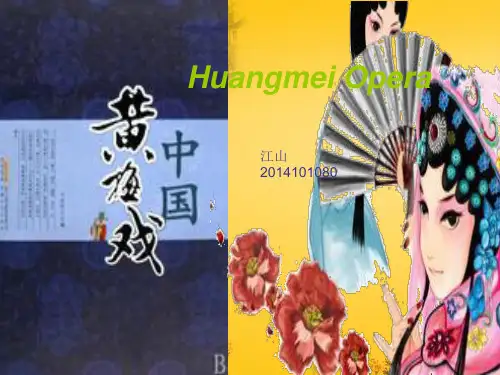
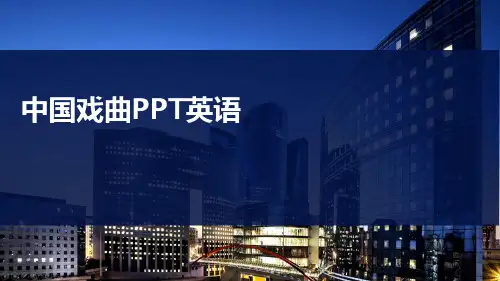
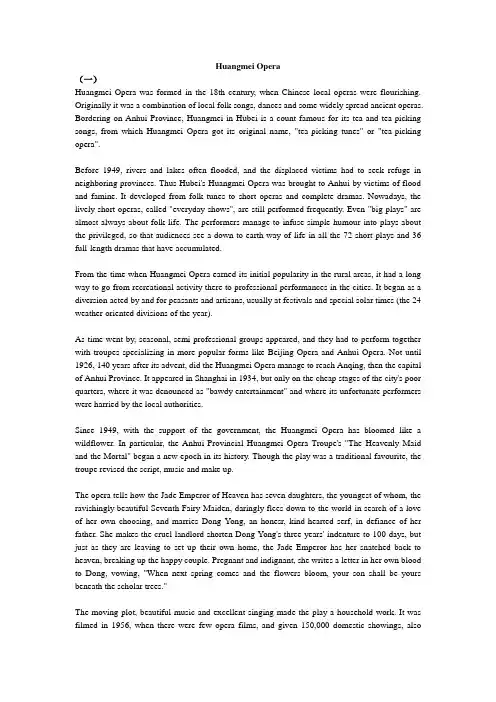
Huangmei Opera(一)Huangmei Opera was formed in the 18th century, when Chinese local operas were flourishing. Originally it was a combination of local folk songs, dances and some widely spread ancient operas. Bordering on Anhui Province, Huangmei in Hubei is a count famous for its tea and tea-picking songs, from which Huangmei Opera got its original name, "tea-picking tunes" or "tea-picking opera".Before 1949, rivers and lakes often flooded, and the displaced victims had to seek refuge in neighboring provinces. Thus Hubei's Huangmei Opera was brought to Anhui by victims of flood and famine. It developed from folk tunes to short operas and complete dramas. Nowadays, the lively short operas, called "everyday shows", are still performed frequently. Even "big plays" are almost always about folk life. The performers manage to infuse simple humour into plays about the privileged, so that audiences see a down-to-earth way of life in all the 72 short plays and 36 full-length dramas that have accumulated.From the time when Huangmei Opera earned its initial popularity in the rural areas, it had a long way to go from recreational activity there to professional performances in the cities. It began as a diversion acted by and for peasants and artisans, usually at festivals and special solar times (the 24 weather-oriented divisions of the year).As time went by, seasonal, semi-professional groups appeared, and they had to perform together with troupes specializing in more popular forms like Beijing Opera and Anhui Opera. Not until 1926, 140 years after its advent, did the Huangmei Opera manage to reach Anqing, then the capital of Anhui Province. It appeared in Shanghai in 1934, but only on the cheap stages of the city's poor quarters, where it was denounced as "bawdy entertainment" and where its unfortunate performers were harried by the local authorities.Since 1949, with the support of the government, the Huangmei Opera has bloomed like a wildflower. In particular, the Anhui Provincial Huangmei Opera Troupe's "The Heavenly Maid and the Mortal" began a new epoch in its history. Though the play was a traditional favourite, the troupe revised the script, music and make up.The opera tells how the Jade Emperor of Heaven has seven daughters, the youngest of whom, the ravishingly beautiful Seventh Fairy Maiden, daringly flees down to the world in search of a love of her own choosing, and marries Dong Yong, an honesr, kind-hearted serf, in defiance of her father. She makes the cruel landlord shorten Dong Yong's three years' indenture to 100 days, but just as they are leaving to set up their own home, the Jade Emperor has her snatched back to heaven, breaking up the happy couple. Pregnant and indignant, she writes a letter in her own blood to Dong, vowing, "When next spring comes and the flowers bloom, your son shall be yours beneath the scholar trees."The moving plot, beautiful music and excellent singing made the play a household work. It was filmed in 1956, when there were few opera films, and given 150,000 domestic showings, alsotravelling to a dozen or so places abroad, so that the obscure wildflower became a masterpiece admired by thousands. The success owed much to the work of renowned performers, among them Yan Fengying, a country girl from Luojialing in Tongcheng County, Anhui Province. A versatile performer who played a variety of roles, she died young, a great loss to the profession. Anqing City put up a statue of Yan Fengying as Seventh Fairy Maiden in one of its parks.The music of Huangmei Opera is its essential attraction. Three kinds of music are used: coloratura, character songs and basic tunes. The 104 coloratura tunes are taken from folk songs, tea-picking songs and other ditties. A short opera usually has its own features, whose name is often the title of the piece, which may owe most of its popularity to the tune. The music of Huangmei Opera is light and lyrical, so a good performer must have facility in this style. Singing is not only the main approach to characterization but also makes Huangmei Opera distinctive stylistically and musically.Huangmei Opera is easy to understand and learn, thanks to its lyrical tunes, simple words and literary tradition. Like other Chinese local operas, Huangmei Opera also used local dialect, in this case that of Huangmei and Anqing, where the opera originated and matured. The language is a mixture of northern and southern and therefore easy for others to imitate while remaining pleasant to native ears. This was conducive to the spread of Huangmei Opera. Its local flavour and folk style are most vividly revealed in its original and lively dialogue, both spoken and sung.Passion, natural and simple, is what makes Huangmei Opera an enduring drama appreciated by all.During the First China Shakespeare Festival in 1986, audiences both at home and abroad watched with respect and inteest an adaptation of Shakespeare's "Much Ado about Nothing" presented by the Anhui Provincial Huangmei Opera Troupe. British Prime Minister Margaret Thatcher sent a message of congratulation to Cao Yu, chairman of the Chinese Dramatists' Association, suggesting that Shakespeare would have been greatly amused by the imaginative representation.(二)Huangmei Opera is a major Chinese local opera popular in Anhui Province, dating back to some 200 years. Originally known as "Huangmei Melody" or "Tea-Picking Opera", the opera is evolved from Huangmei tea-picking tunes based folk songs and dances.The operatic tunes of Huangmei Opera are mostly lyrical, with a lingering charm, very beautiful sounding. There are two major types of tunes: ordinary tunes and florid ornamentations. Ordinary tunes are mainly used in the major sections of the opera to express emotions and tell the story in great length; florid ornamentations are mostly folk songs and tunes. Originally, the key accompaniment instrument was gaohu. Other traditional musical instruments and gongs and drums were also used to make a good effect. Later, a mixed band of Chinese and western musical instruments was introduced. In terms of the performing art of the opera, emphasis has been paid to make the opera close to daily life. The art is well positioned to get across the idea contained in the movements and to express delicate feelings of the characters, as well.There's a wide range of plays in Huangmei Opera. Some portray people airing their grievancesand looking ahead to a bright future and some depict daily rural life. Well known Huangmei Opera plays like Dongyong and Fairy, Emperor's Female Son-in-Law and The Cowherd and The Weaving Girl have been made into movies, causing great impact at home and abroad. Noted Huangmei Opera artists include Yan Fengying, Wang Shaofang, Wu Qiong and Ma Lan etc.(三)Huangmei Opera, an Enduring Folk Art of ChinaHuangmei Opera, also called Huangmei Tune or Caicha Opera, is one of the most noted traditional operas in China among Peking Opera, Shaoxing Opera, Ping Opera and Henan Opera.Huangmei Opera was originated in Huangmei County in Hubei province during the 18th century when Chinese local operas were flourishing. After Huangmei Opera was introduced to Anhui province, it became popular in Anqing County and other neighboring provinces. Nowadays, this opera has grown into a professional performance art in both rural and urban areas, and has become a recreational activity for millions of people.Origin and Development of Huangmei OperaThe Huangmei Opera was derived from the Caicha Tune, meaning tea-picking songs, a type of song that people sang while picking tea. It is a combination of local folk songs, dances, and some widespread ancient operas. As Anhui and Hubei are situated next to each other, Huangmei Opera of Hubei Province was brought to Anhui.Once performed frequently in villages and towns by small groups of local people, Huangmei Opera grew increasingly popular. It developed from folk tunes into short dramas and even completes theatrical works, which can be performed on stage and as TV series.With the support from the government, Huangmei Opera has blossomed since 1949. It has gradually developed from Chinese traditional folk tales to a more diversified opera genre incorporating other opera styles. Nowadays, the lively short operas, called everyday shows, are still performed frequently. Even "big plays" are almost always about folk life. The performers infuse simple humor into all of the 72 short plays and 36 full-length dramas about the privileged life for a down-to-earth element.Huangmei Opera has spread its fame both at home and abroad with its sweet melodies, lyrics, graceful sounds, movements, beautiful costumes and sets. Huangmei Opera’s fans can be found not only in Chinese mainland but also in Hong Kong, Macao, Taiwan, Malaysia, Japan, and even Europe.Characteristics of Huangmei OperaThe costumes of Huangmei Opera contain a distinctive Chinese ancient taste. During the performing process of Huangmei Opera, artists always wear ancient-style garments. Since the contents of the opera are often varied, costumes and sets change according to the opera’s socialenvironment and customs. In some modern Huangmei Operas, artists simply wear ordinary clothes when performing the modern plays.Huangmei Opera music features folk songs that are graceful, sweet-sounding, light, and lyrical. Three types of music are used: coloratura, character songs, and basic tunes. The 104 coloratura tunes are taken from folk songs, tea-picking songs, and other types of songs. Huangmei Opera is easy to understand and learn due to its lyrical tunes, simple words, and literary tradition. Like other Chinese local operas, Huangmei Opera also adopts the local dialect. Since the language is a mixture of northern and southern styles, it is therefore easy to imitate and is pleasant to native ears. Its local flavor and folk style are most vividly revealed in its original and lively dialogue, which is both spoken and sung.Passion, simplicity and purity is what makes Huangmei Opera an enduring drama appreciated by all.。
